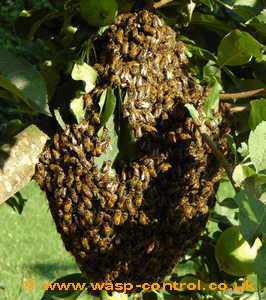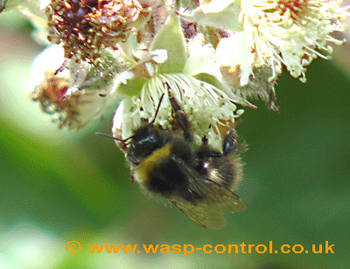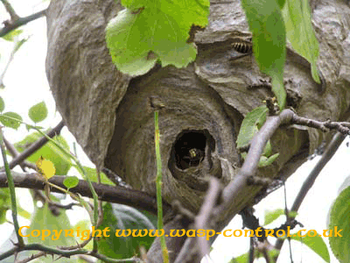Wasp nest identification
How to find Wasp Nests, what to look for
Identifying a wasp nest becomes much easier when you're aware of what to observe. Below, we've provided some notes to assist you in recognizing and locating wasp nests. Take a moment to watch the accompanying video, as it will guide you on the key signs to be mindful of.
Wasp nest identification
Understanding the Situation
To effectively identify a wasp nest, the first step is to observe and discern the ongoing activities. What visual cues are present?
Mid-Summer Visibility
By mid-summer, a fully established wasp nest becomes conspicuous. The location of the nest entrance becomes evident, marked by a continuous flow of wasps traveling to and from the nest.
Concealed Common Wasp Nests
In the case of common wasps, the actual nest is often not visible to the naked eye. Instead, you may notice a hole in the fascia, soffit board, shed wall, or a similar location. The nest remains concealed behind this apparent entrance. To confirm the presence of wasps, spend some time observing. You'll witness wasps arriving at the entrance, disappearing into the nest (or a hole), and others emerging to fly off.
Visual Identification Tips
Refer to the accompanying video for a detailed guide on identifying wasp nests. It provides valuable insights into the visual cues and signs to watch for during the identification process.
Identifying Wasp Nests: What to Observe
If you find yourself consistently bothered by wasps in your garden, it's likely that a nest is nearby. Alternatively, scout wasps may have discovered a food source and communicated its location back to the nest. Wasps are attracted to sweet foods, dead flesh, and trees like Lyme trees dripping with sweet sap.
Swarm Feeding Behavior
Wasps exhibit swarm feeding behavior. A foraging wasp discovering a food source will recruit others from the nest, leading to a rapid increase in their numbers. If your garden experiences constant wasp harassment, identify potential issues such as sweet foods or dead flesh. Additionally, address problems like wasps stripping wood from fence panels or shed walls by treating affected areas with Cuprinol.
Locating the Nest
If you suspect a nest, a brief observation usually reveals flight lines, indicating the concentrated activity and the nest's probable location.
Roof and Loft Examination
A significant wasp nest generates considerable traffic, with numerous wasps entering and leaving at once. Start your search by inspecting yours and your neighbor's roofs, paying close attention to the fascia and soffit areas. Old or worn boards may create entry points, especially if they're rotting. Check areas where TV and electrical cables enter the house, as small gaps might be present.
Sheds and Garages
If roof inspection yields no results, shift your focus to garden sheds and garages. A basic visual examination from the outside is often sufficient to determine the presence of a nest.
Do wasps build nests indoors?
Indoor Wasp Nests: Understanding the Possibility
Discovering wasps inside your home on a daily basis raises the possibility of an indoor wasp nest. Wasps often infiltrate houses through the loft space, utilizing small gaps and cracks in cupboards and poorly fitting loft hatches as entry points.
Loft Space Intrusion
Notably, wasps are known to access homes from the loft space, where gaps and cracks can serve as conduits. In recent observations, it's been observed that wasps are drawn to "Downlights," a lighting system that not only illuminates the intended room but also sheds light into the loft space. Wasps are attracted to this light source and may fall through the small gap between the light bulb and the metal casing.
Surprising Nest Locations
Wasps exhibit the capability to construct nests within houses. Instances include nests found in bedroom cupboards and those emerging through living room ceilings. The range of surprising locations emphasizes the adaptability of wasps in establishing nests within indoor spaces.
Identifying and Treating Indoor Nests
If wasps are consistently present indoors, especially in unexpected areas, it's advisable to investigate the possibility of an indoor nest. Treating such nests may require thorough examination and targeted measures to ensure effective removal and prevention of further intrusion.
Do wasps build nests underground?
Underground Wasp Nests: Unraveling the Challenge
Identifying wasp nests in the ground poses a slightly greater challenge due to the concealment of the entrance. Often, the hole is partially covered or camouflaged with leaves and ground debris. However, persistent observation in areas where wasps are regularly seen can unveil the location of the nest.
Observational Tactics
If wasps are frequently observed coming and going in a specific area, dedicating a few minutes to watch and track their movements can provide valuable insights into the nest's whereabouts.
Potential Nesting Spots
Several locations serve as potential nesting spots for ground-dwelling wasps. These include old compost heaps or bins, garden walls, kids' playhouses, tree holes, beneath patio slabs, coal bunkers, air bricks, and wall cavities. Awareness of these common nesting sites enhances the chances of locating underground wasp nests.
Swarming wasps?
Understanding Swarming Behavior: Bees vs. Wasps
Contrary to bees, wasps do not exhibit swarming behavior. If you come across a congregation of insects hanging from a tree branch or clustering on a surface like a wall or fascia, it's likely a swarm of honey bees.
Differentiating Swarms: Bees and Wasps
To distinguish between bee and wasp swarms, note that honey bees are the ones that form visible masses. When faced with a bee swarm, consult our page on bee removal for guidance on safely relocating them. We provide a comprehensive list of honey bee swarm collectors within the UK, USA and Canada, ready to assist with the removal and rehoming of bee swarms.
Bee Removal Assistance
Bee collectors are readily available to respond to your call and efficiently relocate bee swarms. Keep in mind that these collectors typically deal with honey bees and may not handle bumblebee removal or rehoming.
Identifying Bumblebees
vBumblebees, distinguishable by their furry appearance, are not commonly addressed by honey beekeepers or swarm collectors. If you encounter bumblebees, appreciate their distinctive fuzzy look, as illustrated in the accompanying image. Please note that specialized measures may be required for bumblebee-related concerns.


Common Wasps: Nesting Habits and Life Cycle
The Common Wasp (Vespa Vulgaris) typically constructs nests in various locations, such as roof spaces, garden sheds, air bricks, or even in the ground. It's not uncommon to find their nests in abandoned vole and rabbit burrows. They choose spots that offer protection from the elements and remain undisturbed.
Towards the end of the year, with the onset of frost, any remaining edible fruit quickly perishes. Simultaneously, changes in human activity make it challenging for wasps to find sufficient food, leading to a period of starvation. Wasps, requiring high-energy (sugar) content for flight maintenance, face difficulties as food sources dwindle. Consequently, adult worker wasps begin to die off.
During this time, the new queen wasps enter hibernation, poised to emerge and initiate the reproductive cycle once more in the spring. These queens establish entirely new nests, and the life cycle restarts. Importantly, nests from previous years are never reused in this process.
European Wasps: Identifying Traits and Nest Construction
German wasps, also known as European wasps (Vespula Germanica), exhibit a slightly larger size compared to English wasps. Their nesting habits involve constructing nests in bushes, trees, and hedgerows. At a glance, the nest bears a resemblance to a grey football.
The construction of the nest mirrors that of common wasps, utilizing a mixture of chewed wood and saliva to create a robust papier-mâché material. This nesting material, despite being lightweight, possesses surprising waterproof qualities, ensuring the nest's durability.
